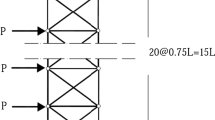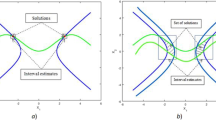Abstract
We consider the problem of finding interval enclosures of all zeros of a nonlinear system of polynomial equations. We present a method which combines the method of Gröbner bases (used as a preprocessing step), some techniques from interval analysis, and a special version of the algorithm of E. Hansen for solving nonlinear equations in one variable. The latter is applied to a triangular form of the system of equations, which is generated by the preprocessing step. Our method is able to check if the given system has a finite number of zeros and to compute verfied enclosures for all these zeros. Several test results demonstrate that our method is much faster than the application of Hansen’s multidimensional algorithm (or similar methods) to the original nonlinear systems of polynomial equations.
Abstract
Рассматрнвается залача нахожлення интервальных оболочек всех корней нелннейной снстемы полиномиальных уравнений. Прелстаилена процелура, обьелиняюшая метод базисов Грёбнера (нснользуемый на нрелварнтельном этаце вычцслений), некоторые методнки интервального аналнза н особую разновидность алгоритма Е. Хансена для решення нелинейных уравнений с одной иеременной. Послелний прнменяется к треугольному уредставлению, снстемы уравнений, сформированному на предварнтельном этапе. Онисываемый метод снособен проверять, нмеет, ли данная снстема конечное чнсло корней, и вычнслять вернфицированные ободочкн для всех корней. Несколько чнсленных прнмеров ноказывают, что наш метод является намного более быстрым, чем многомерный алгорнтм Нансена (илп аналогичные методы) в нрименении к исходным нелииейным снстемам полнномнальных уравнений.
Similar content being viewed by others
References
Alefeld, G. andHerzberger J..Introduction to interval computations, Academic Press, New York, 1983.
Buchberger, B..Ein algorithmisches Kriterium für die Lösbarkeit eines algebraischen Gleichungssystems. Aequationes Mathematicae4 (1970), pp. 374–383.
Buchberger, B..Theoretical basis for the reduction of polynomials to canonical forms.SIGSAM Bulletin 39 (1976), pp. 19–29.
Buchberger, B..Some properties of Gröbner bases for polynomial ideals. SIGSAM Bulletin40 (1976). pp. 19–24.
Buchberger, B..A criterion for detecting unnecessary reductions in the construction of Gröbner bases. In: “Proceedings of the 1979 European Symposium on Symbolic and Algebraic Computation”. Lecture Notes in Computer Science 72, Springer-Verlag, Berlin, Heidelberg, 1979. pp.3–21.
Buchberger, B.H-bases and Gröbner bases for polynomial ideals. CAMP-Linz publication 81-20, University of Linz. 1981.
Buchberger, B.A. survey on the method of Gröbner bases for solving problems in connection with systems of multivariate polynomials. In: Inada, N. and Soma, T. (eds) “Proceedings of the 2nd RIKEN Symposium on Symbolic and Algebraic Computation”, World Scientific Publ., 1985, pp. 69–83.
Davenport, J. H., Siret, Y., and Tournier, E.Computer algebra, systems and algorithms for algebraic computation. Academic Press, New York, 1988.
Gaganov, A. A.Computational complexity of the range of the polynomial in several variables. Cybernetics (1985). pp. 418–421.
Hammer, R., Hocks, M., Kulisch U., and Ratz, D.Numerical toolbox for verified computing I — Basic numerical problems. Springer-Verlag, Heidelberg, 1993.
Hansen, E..A globally convergent interval method for computing and bounding real roots. BIT18 (1978), pp. 415–424.
Hansen, E.Global optimization using interval analysis. Marcel Dekker, New York, 1992.
Kearfou R. B., Hu, C. and Novoa, M.A review of preconditioners for the interval Gauss-Seidel method. Interval Computations1 (1991), pp. 59–85.
Klatte, R., Kulisch, U., Neaga, M., Ratz, D., and Ullrich, Ch.PASCAL-SSC — language reference with examples. Springer-Verlag, Berlin etc., 1992.
Kulisch U. and Miranker, W. L.Computer arithimetic in theory and practice. Academic Press, New York, 1981.
Moore, R. E..Interial analysis. Prentice-Hall, Englewood Cliffs, 1966.
Neumaier, A.Interval methods for systems of equations. Cambridge University Press, Cambridge, 1990.
Stoer, J. and Bulirsch, R.Introduction to numerical analysis. Springer-Verlag, New York, 1980.
van der Waerden, B. L.Modern algebra, Fréderick Ungar, New York, 1949.
Author information
Authors and Affiliations
Rights and permissions
About this article
Cite this article
Jäger, C., Ratz, D., йегер, К. et al. A combined method for enclosing all solutions of nonlinear systems of polynomial equations. Reliable Comput 1, 41–64 (1995). https://doi.org/10.1007/BF02390521
Received:
Revised:
Issue Date:
DOI: https://doi.org/10.1007/BF02390521




